Class 7 Social Science Chapter 11 Let's Explore - From Barter to Money
| Table of contents |

|
| Page 231 & 236: Why Do we Need Money? |

|
| Page 232 to 237: Think About It |

|
| Page 238 & 239: The Journey of Money |

|
| Page 242: Paper Money |

|
Page 231 & 236: Why Do we Need Money?
Q: Imagine that you are a farmer and that people use a barter system where you live. You need a whole variety of things - a pair of new shoes, a sweater, and medicines for your grandmother. But you only have an ox that you can spare. How would you be able to exchange the ox for all the different things you need from different people or places? What difficulties are you likely to face?
Ans: Exchanging the Ox: To get shoes, a sweater, and medicines, the farmer must find people who need an ox and offer the desired items. This might involve multiple trades, e.g., trading the ox for wheat, then wheat for shoes, and so on, requiring travel to different places.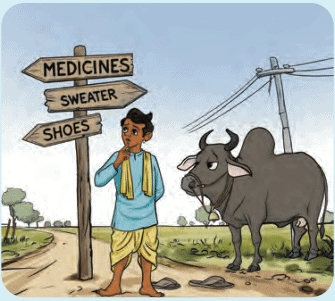
Difficulties:
- Double Coincidence of Wants: Finding someone who wants an ox and has shoes, a sweater, or medicines.
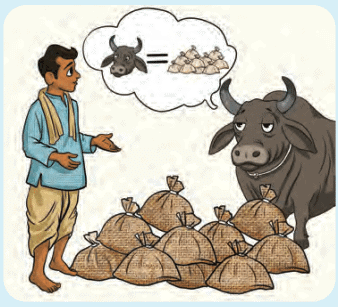
- Value Disparity: An ox is worth more than a single item, complicating fair exchange proportions.
- Portability: Transporting the ox or intermediate goods (e.g., wheat) is cumbersome.
- Divisibility: An ox cannot be divided for smaller trades.
- Storage: Intermediate goods like wheat may spoil, unlike durable money.
Q: The illustrations above show you some of the ways in which people practise barter today. Have you observed similar practices in your locality? What are the types of experiences people have in this process?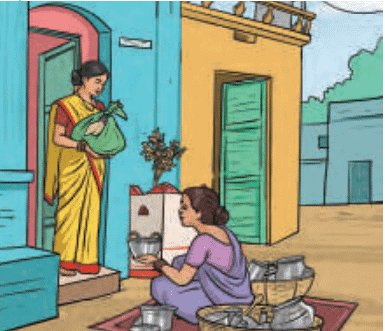
Ans: Local Barter Practices: Students should identify local examples, e.g., exchanging old clothes for utensils (page 235), trading books in a book club, or swapping produce at local markets. Example: “In my village, people exchange vegetables from their gardens for homemade snacks.”
Experiences:
- Positive: Builds community trust, saves money, and recycles goods (e.g., Junbeel Mela, page 234).
- Challenges: Difficulty finding matching needs (double coincidence), disagreements over item values, or limited goods to trade.
- Cultural Value: Strengthens social bonds, as seen in tribal fairs, but requires negotiation skills and mutual agreement on fairness.
Page 232 to 237: Think About It
Q: What are the different types of difficulties you encountered in the situation above?
Ans: In the farmer’s barter scenario (page 231):
- Double Coincidence of Wants: Finding someone who needs an ox and offers shoes, a sweater, or medicines (page 233).
- Lack of Common Value Measure: Difficulty agreeing on fair exchange ratios (e.g., how much wheat equals a sweater).
- Divisibility Issue: An ox cannot be split for smaller trades.
- Portability Problem: Transporting an ox or wheat to multiple traders is impractical.
- Storage Issue: Wheat may rot, unlike durable money (page 234).
These challenges highlight the barter system’s inefficiencies, leading to money’s development (page 236).
Q: What are the instances of double coincidence of wants in the above example?
Even if there are two people who want each other's goods and are also willing to make an exchange, other issues could arise—in what proportion should the two goods be exchanged? In such cases, it becomes difficult to compare the value of one good against another. If one of the people feels that the exchange is disadvantageous, they would not be interested in the exchange. This is because there is no common standard measure of value. In the situation given above, what are the cases where you could encounter the lack of a common standard measure of value?
Ans: Instances of Double Coincidence of Wants:
- The farmer needs shoes and finds a shoemaker who wants an ox.
- The farmer needs a sweater and finds a weaver who wants an ox.
- The farmer needs medicines and finds a healer who wants an ox.
Each case requires the other party to desire the ox while offering the exact item the farmer needs (page 233).
Lack of Common Standard Measure of Value:
- Case 1: Determining how many pairs of shoes equal an ox’s value—e.g., one pair may seem too little, but ten pairs too many.
- Case 2: Agreeing on how much wheat equals a sweater, as perceptions of value differ (e.g., farmer values wheat more, weaver values sweater).
- Case 3: Deciding how many doses of medicine match the ox’s worth, with no standard to compare.
Without a common measure (e.g., money), negotiations falter, as parties may feel the trade is unfair (page 233).
Q: What are the different ways in which money would make the above situation easier for the farmer?
Ans: Money simplifies the farmer’s situation (page 231) by:
- Eliminating Double Coincidence: The farmer sells the ox for money and buys shoes, a sweater, or medicines from anyone, without needing mutual wants (page 233).
- Common Value Measure: Money standardizes value (e.g., ox = ₹5000, shoes = ₹500), enabling fair exchanges (page 237).
- Divisibility: Money can be divided (e.g., ₹100 for medicines, ₹400 for a sweater), unlike an ox (page 233).
- Portability: Money is easy to carry, unlike an ox or wheat (page 233).
- Durability: Money (coins, notes) lasts longer than wheat, serving as a store of value (page 237).
- Deferred Payments: The farmer can save money for future purchases or pay later (page 237), easing trade logistics.
Q: Suppose you need to buy a book. You have ₹50 in your pocket. You visit the bookshop in your neighbourhood where the shopkeeper tells you that the book is worth ₹100. What options do you have to buy the book today? Will you request the shopkeeper to allow you to make the rest of the payment later?
Ans: Options to Buy the Book Today:
- Pay ₹50 now and request deferred payment for the remaining ₹50, promising to pay later (standard of deferred payment, page 237).
- Borrow ₹50 from a friend or family member to pay the full ₹100.
- Trade an item (e.g., old books) plus ₹50, if the shopkeeper agrees to a partial barter.
- Negotiate a discount to fit the ₹50 budget, though unlikely.
Request Deferred Payment? Yes, requesting to pay the remaining ₹50 later is practical, as money’s role as a standard of deferred payment allows credit arrangements (page 237). The shopkeeper might agree if they trust you, common in small communities. Alternatively, exploring other options like borrowing ensures the purchase without relying solely on credit.
Page 238 & 239: The Journey of Money
Q: Look at the timeline given below. What are the changes in money that you observe?
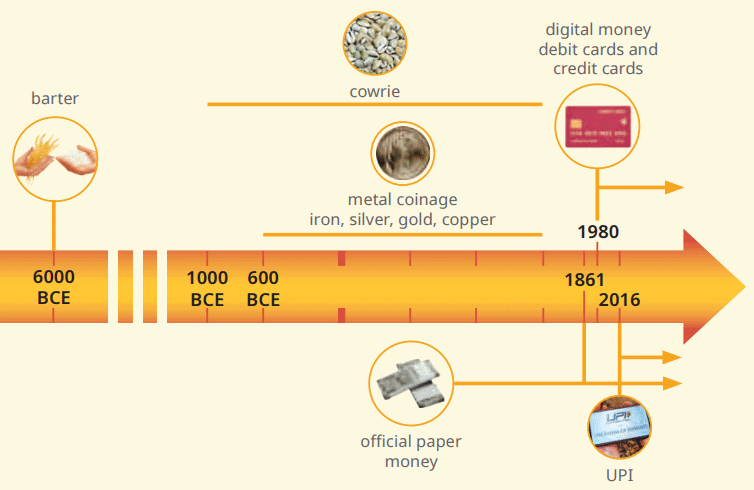 Fig. 11.10. Evolution of money in India - a broad timeline
Fig. 11.10. Evolution of money in India - a broad timeline
Ans: Changes Observed in Timeline:
- Barter to Commodities: Early trade used goods like cowrie shells, salt, or cattle (page 230).
- Commodity Money: Items like Rai stones, Aztec copper Tajadero, and feather coils served as money (page 230).
- Coins: Introduced as standardized metal currency (e.g., kārshāpanas, panas) by rulers, made of gold, silver, or copper alloys, with symbols like Varaha or parasols (pages 238–239).
- Paper Currency: Emerged in China, introduced in India in the late 18th century (page 242), replacing heavier coins for higher denominations.
- Digital Money: Modern forms like UPI, debit/credit cards, and QR code payments (page 243), enabling intangible, electronic transactions.
These changes reflect evolving needs for portability, durability, and ease of use in transactions.
Q: The coins shown in Fig. 11.12 were found during excavations in Pudukkottai in Tamil Nadu. Their heads embossed are those of Roman kings. What conclusions can we draw from such a finding?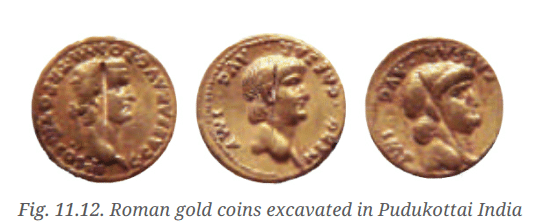
Ans: Conclusions:
- Trade Connections: Roman coins in Pudukkottai (page 240) indicate maritime trade between southern India and the Roman Empire, likely via ports in Kerala and Tamil Nadu.
- Economic Strength: The presence of gold coins suggests India’s favorable trade balance, exporting goods like spices or textiles (page 240).
- Cultural Exchange: Coins reflect interactions beyond trade, possibly influencing local coin designs or economic practices.
- Standardized Currency: Roman coins’ acceptance in India shows trust in their value, facilitating cross-regional commerce.
Page 242: Paper Money
Q: Look at a 50 and a 100-rupee note. Can you identify the motifs depicting India's cultural heritage on the reverse side of the notes? Find out more about them.
Feel the surface of the notes. What special features of currency notes help visually impaired persons to identify the notes' denominations?
Ans: Motifs on Notes:
- ₹50 Note: Reverse depicts Hampi (Vijayanagara ruins), a UNESCO World Heritage Site, symbolizing India’s architectural and historical heritage.
- ₹100 Note: Reverse shows Rani ki Vav, a stepwell in Gujarat, another UNESCO site, reflecting ancient engineering and cultural legacy.
- Details: Hampi’s stone chariot and temples highlight Vijayanagara’s grandeur; Rani ki Vav’s intricate carvings showcase medieval artistry. Students can research via RBI websites or history books.
Features for Visually Impaired:
- Raised Print (Intaglio): ₹50 and ₹100 notes have raised denomination numerals (e.g., “50” or “100”) on the right side, identifiable by touch.
- Tactile Markers: Distinct shapes (e.g., triangle for ₹100, square for ₹50) in raised print aid identification.
- Size Difference: ₹100 notes are slightly larger than ₹50 notes.
- Braille-Like Patterns: Embossed patterns near edges assist in denomination recognition.
These features, mandated by the RBI, ensure accessibility (page 243).
|
23 videos|272 docs|12 tests
|
FAQs on Class 7 Social Science Chapter 11 Let's Explore - From Barter to Money
| 1. What is the barter system and how did it work? |  |
| 2. Why did societies move from barter to using money? |  |
| 3. What are the characteristics of money that make it effective? |  |
| 4. What forms of money have existed throughout history? |  |
| 5. How does modern money differ from traditional forms of money? |  |















